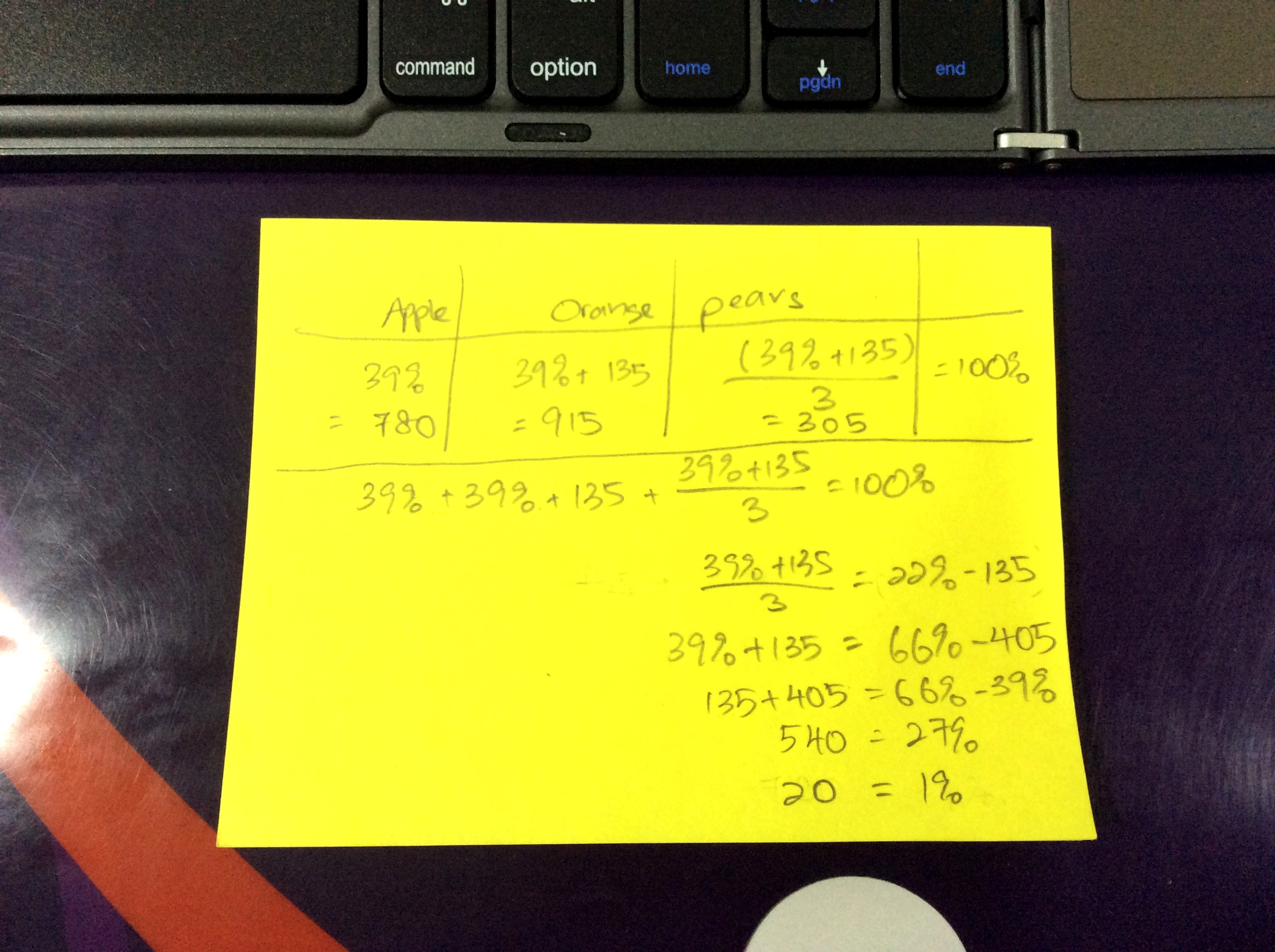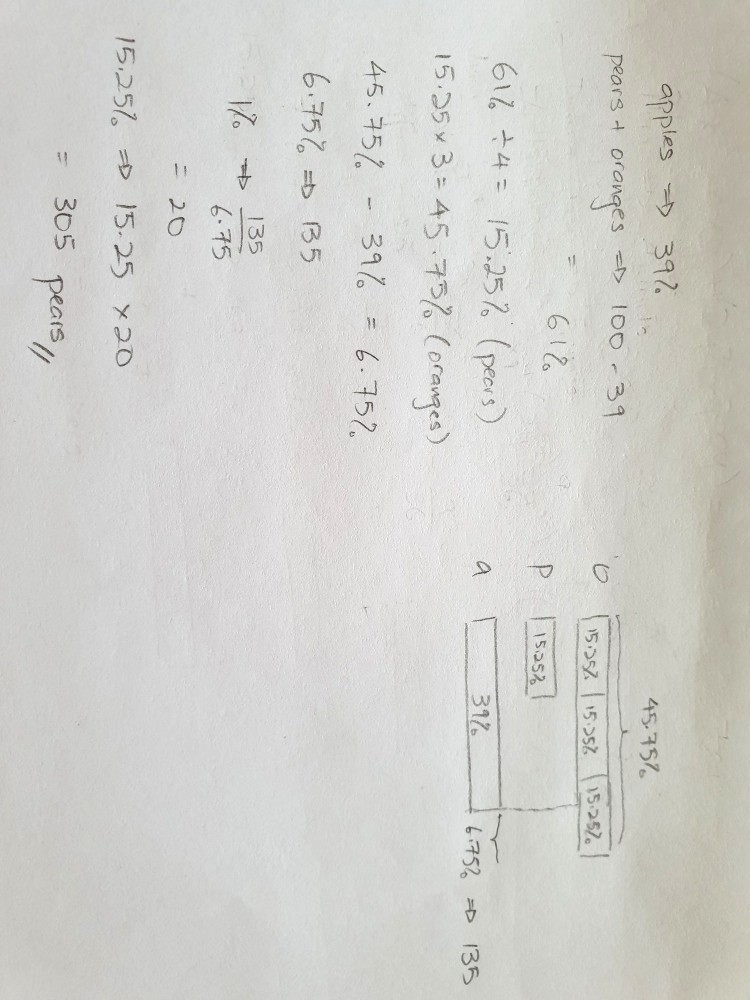Ask Singapore Homework?
Upload a photo of a Singapore homework and someone will email you the solution for free.

Question
primary 6 | Maths
| Fractions
2 Answers Below
Anyone can contribute an answer, even non-tutors.

Not sure how to form equatiion, pls help. Tks
135 more oranges than apples.
Oranges is 3 times pears.
This one is straightforward. Let number of fruits be 100 units so that number of apples is 39 units.
The remaining 61 units is made up of oranges and pears. Sadly 61 is not divisible by 4 (at least to a whole number), so I redefine the question all over again.
Let the number of fruits be 400 units so that the number of apples is 156 units.
The remaining 244 units is made up of oranges and pears. Since there are three times as many oranges as pears, there must have been 61 units of pears and 183 units of oranges.
As we can see, there are 27 units of oranges more than apples.
27 units —> 135 extra oranges
1 unit —> 5 fruits
61 units —> 305 pears
Oranges make up 183 units.
Their difference is 183 - 156 = 27 units.
I express the 400 units for simplicity so that the numbers you will be dealing with are all whole numbers. Without this, your units will be in decimals.
Of course, 39% of oranges would be 39% of 400 units which is 156 units.
The remainder is 244 units, which would be divided into oranges and pears such that there are 3 times as many oranges as pears.
Let’s call the number of units of pears 1 UNIT.
Then there would be 3 UNITS of oranges, and therefore a total of 4 UNITS of oranges and pears.
4 UNITS —> 244 units
1 UNIT —> 61 units
3 UNITS —> 183 units
As we can see, there must have been 61 units of pears and 183 units of oranges (not forgetting the 156 units of apples earlier).
In this respect, the number of fruits in each “unit” is the same.
So from here, we can see that there are 183 - 156 = 27 units of oranges more than apples.
This 27 units corresponds to the “135 more oranges than apples”.
That being said, you can continue to use 100 units instead of my 400 units if you prefer.
It would then go like this.
39% of fruits are apples, so 39 units are apples.
The remaining 61 units are to be shared between oranges and pears such that the number of oranges is three times the number of pears.
So there is 1 UNIT of pears and 3 UNITS of oranges (note: here UNIT is not the same as unit).
4 UNITS —> 61 units
1 UNIT —> 15.25 units (if you do not mind the decimals, then this method is ok)
3 UNITS —> 45.75 units
So there are 15.25 units of pears and 45.75 units of oranges. Do not forget the 39 units of apples.
Then there must have been 45.75 - 39 = 6.75 units more oranges than apples.
6.75 units —> 135
1 unit —> 20
15.25 units —> 305
So there are 305 pears.
The reason why I use a different method from the tutor is that technically percentages are not allowed to be added with regular numbers.
For example, we cannot say that
30% + 250 = 500
This presentation of workings is mathematically incorrect.
1 unit → 5 would be marked down
1 unit = 5 is the correct way to present
As for percentage at PSLE,
Arrows are to be used right after the percentage sign is written, provided you do not have any qualifiers after the percentage sign.
If you write equal sign after the percentage sig you will be marked down.
Eg. 100% → 500
1% → 500 ÷ 5 = 100
1% = 500 ÷ 5 = 100
The first is the standard way to present.
The second is acceptable as the equal sign is part of the calculation and not the statement about the percentage.
The third will be marked down in PSLE.
However, if you add a 'of ___' , there's a qualifier . Then equals sign is acceptable.
Eg. 30% of pears + 50 pears = 1000 pears
Lastly, in order to prevent confusion for the marker,
If you have used 'units' already.to represent the 39%, then to represent the 61% being divided into 4, instead of 'UNITS' , you could use 'parts' instead
(The terms unit and part are very common in PSLE answering , esp for questions involving unit-part method)
As for adding percentages to numbers, rather than being mathematically incorrect, it's more commonly used in different ways
It also depends on the presentation standards accepted by the examining body or institutions which differ across the world and exam boards.
Eg. 250 + 30% could refer to
① Adding 30% of 250, to 250
Or
② Adding 0.3 or 3/10 to 250
But it is never used in the way like
250 + 30% = 500 as from either way of usage, one will not get 500. Therefore the qualifier 'of ____' has to be used.
See 2 Answers
Mandy, the “780” is likely the tutor’s answers for the number of apples so you can cross check the validity of the answers at the end.
Number of oranges
= 39% of total number of fruits + 135
= 3 x (13% of total number of fruits + 45)
These numbers are divisible by 3 and is what the question wants you to do.
Number of pears are ⅓ of the number of oranges.
Number of pears = 13% of total number of fruits + 45
Number of fruits that are oranges and pears
= (100% - 39%) of the total number of fruits
= 61% of the total number of fruits.
Number of thats are pears and oranges also = 13% of total number of fruits + 45 + 39% of total number of fruits + 135
= 52% of total number of fruits + 180
Comparing the two,
61% - 52% = 9%
So 9% → 180 fruits
1% → 180 fruits ÷ 9 = 20 fruits
Pears →13% + 45
= 13 x 20 + 45
= 260 + 45
= 305
The above working is best represented using models, where you can see how 61% and 52% + 180 equate to each other.
The idea is you can cut 39% into 3 equal parts and 135 into 3 equal parts then recombine into 4 sets, each set being 13% + 45.








